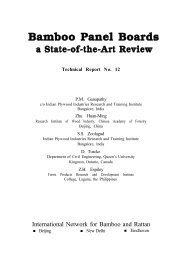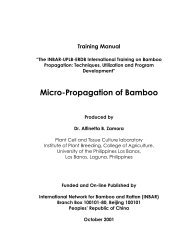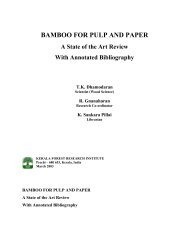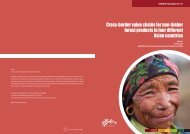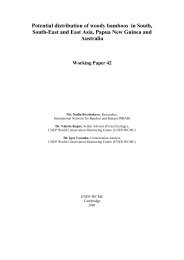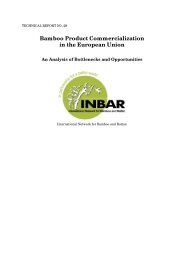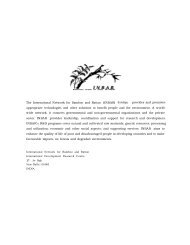The Bamboo and Rattan Sectors in Asia: an Analysis of ... - INBAR
The Bamboo and Rattan Sectors in Asia: an Analysis of ... - INBAR
The Bamboo and Rattan Sectors in Asia: an Analysis of ... - INBAR
Create successful ePaper yourself
Turn your PDF publications into a flip-book with our unique Google optimized e-Paper software.
3. <strong>The</strong> current market is highly volatile, with the <strong>in</strong>herent seasonality <strong><strong>an</strong>d</strong><br />
perishability <strong>of</strong> the commodities (shoots <strong><strong>an</strong>d</strong> culms) coupled with rapid entry <strong><strong>an</strong>d</strong><br />
exit from the market by traders, <strong><strong>an</strong>d</strong> relatively poor <strong>in</strong>formation systems. Farmers<br />
could org<strong>an</strong>ize themselves <strong>in</strong>to market<strong>in</strong>g associations or collectives that would give<br />
them stronger barga<strong>in</strong><strong>in</strong>g power.<br />
4. <strong>The</strong> m<strong>an</strong>ufactur<strong>in</strong>g <strong>in</strong>dustries should further diversify their products <strong><strong>an</strong>d</strong><br />
markets. Currently more th<strong>an</strong> 50% <strong>of</strong> product exported go to just three dest<strong>in</strong>ations:<br />
Jap<strong>an</strong>, Korea <strong><strong>an</strong>d</strong> Taiw<strong>an</strong>-Ch<strong>in</strong>a.<br />
5. M<strong>an</strong>ufacturers would also benefit from greater stability <strong>in</strong> raw material supply.<br />
This could be achieved through stronger l<strong>in</strong>kages among raw material buyers <strong><strong>an</strong>d</strong><br />
suppliers.<br />
6. Research is required: to further <strong>in</strong>crease productivity <strong>in</strong> both shoots <strong><strong>an</strong>d</strong> culms<br />
production; to lengthen the feasible harvest period for both shoots <strong><strong>an</strong>d</strong> culms as a<br />
me<strong>an</strong>s to reduce the fluctuation <strong>in</strong> supplies to the <strong>in</strong>dustries; to help determ<strong>in</strong>e optimal<br />
shoots versus culms production trade-<strong>of</strong>fs: to improve the quality <strong><strong>an</strong>d</strong> efficiency <strong>of</strong><br />
production <strong>of</strong> bamboo-based products.<br />
<strong>The</strong> <strong>Ratt<strong>an</strong></strong> Sector<br />
<strong>The</strong> Laos <strong>Ratt<strong>an</strong></strong> Sector 14<br />
Introduction<br />
Commercial trade <strong>in</strong> ratt<strong>an</strong> <strong>in</strong> Laos was very much limited <strong><strong>an</strong>d</strong> restricted to<br />
domestic consumption until about 1990. Export trade emerged when supplies from<br />
the traditional ratt<strong>an</strong> producers decl<strong>in</strong>ed <strong>in</strong> the <strong>in</strong>ternational market. <strong>The</strong>re is a grow<strong>in</strong>g<br />
domestic ratt<strong>an</strong> furniture market <strong><strong>an</strong>d</strong> <strong>in</strong>creas<strong>in</strong>g exports <strong>of</strong> semi-processed ratt<strong>an</strong>,<br />
ma<strong>in</strong>ly to Vietnam. <strong>Ratt<strong>an</strong></strong> is also import<strong>an</strong>t as food <strong>in</strong> Laos (as <strong>in</strong> parts <strong>of</strong> Thail<strong><strong>an</strong>d</strong>):<br />
ratt<strong>an</strong> shoots are considered a delicacy, <strong><strong>an</strong>d</strong> thought to promote good health. Although<br />
wild natural st<strong><strong>an</strong>d</strong>s are the ma<strong>in</strong> source <strong>of</strong> ratt<strong>an</strong> shoots, farmers are <strong>in</strong>creas<strong>in</strong>gly<br />
tak<strong>in</strong>g up ratt<strong>an</strong> cultivation for shoot production.<br />
<strong>The</strong> ratt<strong>an</strong> sector <strong>in</strong> Laos is relatively small. <strong>The</strong>re are a few commercial-scale<br />
ratt<strong>an</strong> furniture m<strong>an</strong>ufacturers. <strong>The</strong> total <strong>an</strong>nual allowable cut (AAC) <strong>in</strong> 1995-96 was<br />
649 000 large diameter c<strong>an</strong>es <strong><strong>an</strong>d</strong> 425 000 small diameter c<strong>an</strong>es (each <strong>of</strong> 4.5-5 m<br />
length). <strong>The</strong> recorded harvests, however, were well below the AAC limits.<br />
Nevertheless, ratt<strong>an</strong> forms a critical part <strong>of</strong> the <strong>in</strong>come <strong>of</strong> those <strong>in</strong>volved <strong>in</strong> gather<strong>in</strong>g<br />
it, <strong><strong>an</strong>d</strong> it is grow<strong>in</strong>g <strong>in</strong> import<strong>an</strong>ce <strong>in</strong> terms <strong>of</strong> employment generation <strong><strong>an</strong>d</strong> export earn<strong>in</strong>gs.<br />
14 By Vongvilay Vongkhamsao, Khamphone Sengdala <strong><strong>an</strong>d</strong> Bouahome Sengkhamyong (Forest Research<br />
Center, Department <strong>of</strong> Forestry, Vienti<strong>an</strong>e, Laos).<br />
39



